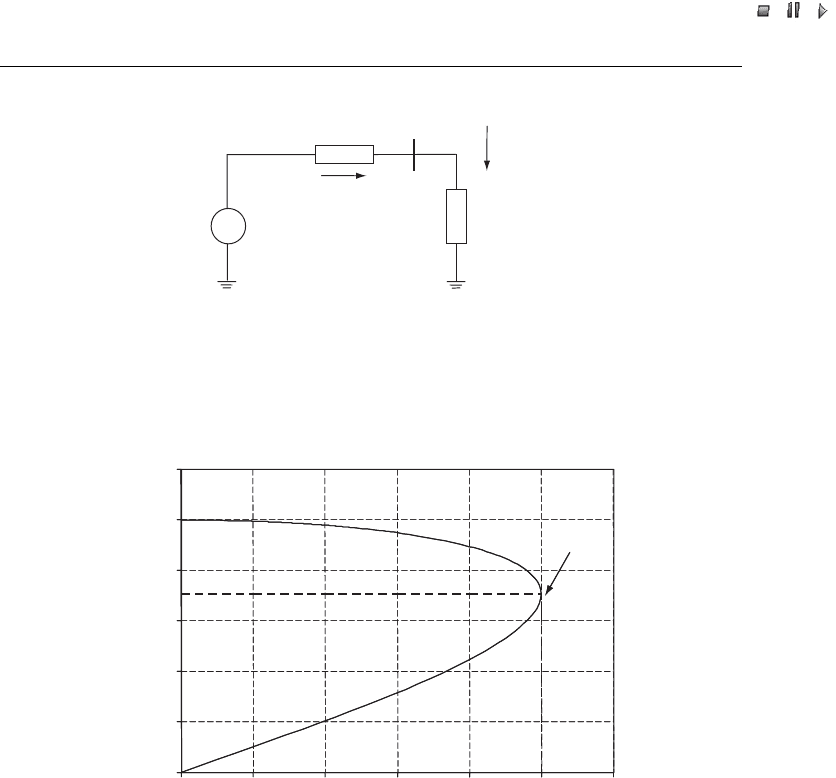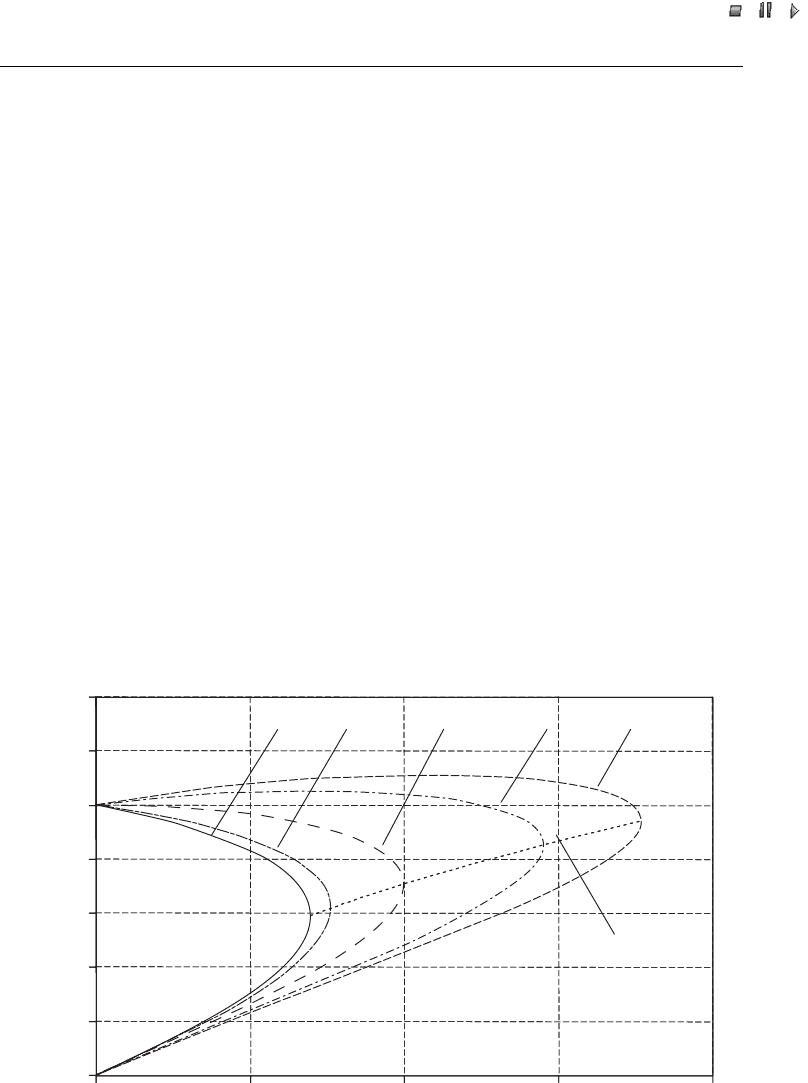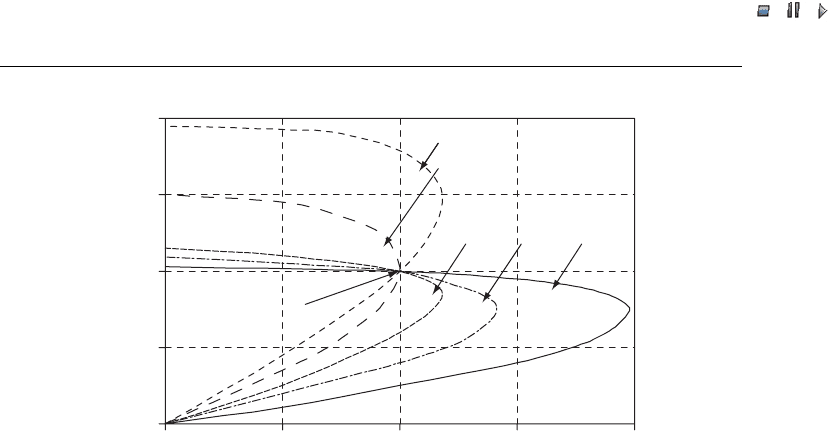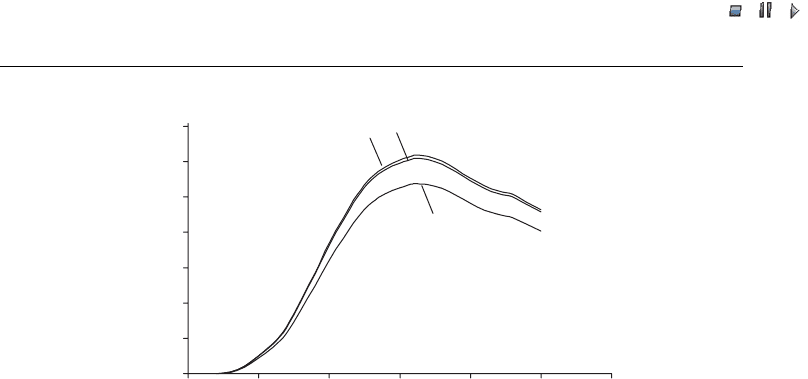AckermannTh. (ed) Wind Power in Power Systems
Подождите немного. Документ загружается.


//INTEGRAS/KCG/P AGIN ATION/ WILEY /WPS /FINALS_1 4-12- 04/0470855088_ 20_CHA19 .3D – 431 – [411–432/22]
17.12.2004 10:55PM
Table 19.1 shows that, compared with the unity power factor operatin g mode, the
converter current rating must be higher for reactive power g eneration and consump-
tion. In the case of doubly fed induction generators, for reactive power consumption
the converter current rating can be lower than for reactive power generation. The
reason is that the generator in this wind turbine type is grid coupled. The magnetising
current can be drawn from the grid instead of being provided by the converter. In
this mode of operation, reactive power is consumed and less converter current is
needed than for the generation of the same amount of reactive power. Full voltage
control capability requires that reactive power can be both generated and consumed.
Therefore, reactive power generation is the determining factor in sizing the converter
when equipping a doubly fed induction generator based wind turbine with a voltage
controller.
Finally, Table 19.1 shows how much the converter current rating has to be increased
in order to achieve voltage control capability. The relative increa se of converter size is
largest in the case of the doubly fed induction generator based turbine. It now could be
hastily concluded that it is more expensive to equip a doubly fed induction generator
based wind turbine with a voltage controller than a direct-drive wind turbine. However,
this conclusion is not necessarily correct. The converter in a direct-drive wind turbine is
larger and thus more expen sive than in a doubly fed induction generator based wind
turbine. This means that, although the relative increase in converter cost will be smaller
in the case of the direct-dri ve win d turbine, the absolute cost increase may be substan-
tially higher. Therefore, the costs for equipping a wind turbine with voltage control
capability must be studied carefully for both concepts.
19.6 Conclusions
This chapter has discussed the impact of wind power on voltage control and the voltage
control capabilities of various current wind turbine types. It was pointed out
Table 19.1 Converter phase current for varying amounts
of reactive power, Q, for wind turbine Types B and C when
frequency, f, is 50 Hz, active power, P, is 2 MW and
terminal voltage, U
t
, is 700 V
Q Converter current rating (A)
Doubly fed Direct drive
0 MVAR 537 1650
1 MVAR generation 845 1845
percentage change
a
þ57:4 þ11:8
1 MVAR consumption 618 1845
percentage change
a
þ15:0 þ11:8
a
Percentage change relative to Q ¼ 0 MVAR case (unity
power factor operating mode).
Wind Power in Power Systems 431

//INTEGRAS/KCG/P AGIN ATION/ WILEY /WPS /FINALS_1 4-12- 04/0470855088_ 20_CHA19 .3D – 432 – [411–432/22]
17.12.2004 10:55PM
.
that voltage control is necessary because of the susceptance and impedance of the
transformers, lines and cables that make up electrical networks;
.
that node voltages are strongly related to branch currents, or power flows;
.
that owing to recent developments the voltage control capa bilities of wind turbines
are becoming increasingly important, independent of whether they are connected to
transmission networks or to distribution grids.
We have also looked at the most important current wind turbine concepts and their
voltage control capabilities. It was concluded that the directly grid coupled asynchro-
nous generator is not capable of terminal voltage control whereas turbines that are
equipped with a doubly fed induction generator and a direct-drive synchronous gen-
erator can control the terminal voltage. However, in practice, this possibility is often not
used. Therefore, the terminal voltage behaves similarly to a conventional directly grid
coupled asynchronous generator.
Dynamic simulations were carried out and it was concluded that the terminal voltage
variation is smoothest in the case of variable-speed wind turbines with voltage control.
Furthermore, it was shown that only wind turbines with voltage control can compensate
a drop in grid voltage. Finally, the drawback of terminal voltage control by wind
turbines was discussed: that is, the need for an increased converter rating when com-
pared with unity power factor operation.
References
[1] Abdin, E. S., Xu, W. (2000) ‘Control Design and Dynamic Performance Analysis of a Wind Turbine–
Induction Generator Unit’, IEEE Transactions on Energy Conversion 15(1) 91–96.
[2] Ackermann, T., Andersson, G., So
¨
der, L. (2001) ‘Distributed Generation: A Definition’, Electric Power
Systems Research 57(3) 195–204.
[3] Grainger, J. J., Stevenson Jr., W. D. (1994) Power System Analysis, McGraw-Hill, New York.
[4] Heier, S. (1998) Grid Integration of Wind Energy Conversion Systems, John Wiley & Sons Ltd., Chichester,
UK.
[5] Hingorani, N. G., Gyugyi, L. (1999) Understanding FACTS, Wiley–IEEE Press, New York.
[6] Svensson, J. (1996) ‘Possibilities by Using a Self-commutated Voltage Source Inverter Connected to a
Weak Grid in Wind Parks’, in 1996 European Union Wind Energy Conference and Exhibition, Go
¨
teborg,
Sweden, 20–24 May 1996, pp. 492–495.
[7] Wind, T. (1999) ‘Wind Turbines Offer New Voltage Control Feature’, Modern Power Systems 15(11) 55.
432 Voltage Control

//INTEGRAS/KCG/P AGIN ATION/ WILEY /WPS /FINALS_1 4-12- 04/0470855088_ 21_CHA20 .3D – 433 – [433–460/28]
17.12.2004 10:43PM
20
Wind Power in Areas with
Limited Transmission Capacity
Julija Matevosyan
20.1 Introduction
Historically, transmission systems are built together with power production installations
in order to meet the expected electricity consumption. For economic reasons, they are
usually not overdimensioned and therefore cannot guarantee power transmission cap-
acity for new power plants for 100 % of the year.
Wind power plants have to be installed in the immediate proximity of the resou rce –
wind. The best condition s for an installation of wind power can usually be found in
remote, open areas with low population densities. The transmission system in such areas
might not be dimensioned to accommodate additional large-scale power plants. The
thermal limits of the conductors, voltage and transient stability considerations rest rict
transmission capability during extreme situations, such as during low local loads and
high wind power production.
This chapter covers the issues concerning the integration of new generation (particu-
larly from wind power) in areas with limited transmission capacity. We will start in
Section 20.2 with an overview of different congestion types and some conventional
measures to overcome them. In Section 20.3 we present different approaches used by
transmission system operators (TSOs) to determine transmission capacity. In Section 20.4
we look at ‘soft’ and ‘hard’ grid reinforcement measures to increase transmission
capacity. The problems associated with the integration of new wind generation in areas
with limited transmission capacity are discussed in the Section 20.5. In Section 20.6 we
present methods to estimate the amount of wind power that can be integrated in areas
with limited transmission capacity before grid reinforcement becomes the more
Wind Power in Power Systems Edited by T. Ackermann
Ó 2005 John Wiley & Sons, Ltd ISBN: 0-470-85508-8 (HB)

//INTEGRAS/KCG/P AGIN ATION/ WILEY /WPS /FINALS_1 4-12- 04/0470855088_ 21_CHA20 .3D – 434 – [433–460/28]
17.12.2004 10:43PM
economical option. The example of the Swedi sh power system is used to illustrate the
results of the estimation methods. In Section 20.7 we briefly present conclusions.
20.2 Transmission Limits
Power transmission in a system may be subjected to the thermal limits of the conductors
as well as to limits in relation to voltage and transient stability considerations. Thermal
limits are assigned to each separate transmission line and the respective equipment.
Limits arising from voltage and transient stability considerations are always studied by
taking into account the operation of the whole power system or a part of it. In the
following sections we provide details regarding transmission limits.
20.2.1 Thermal limit
Overhead transmission lines reach their thermal limit if the electric current heats the
conductor material to a temperature above which the conductor material will start to soften.
The maximum permissible continuous conductor temperature varies between 50
Cand
100
C, depending on the material, its age, the geometry, the height of the towers, the security
standards that limit the clearance from the ground and so on. (Haubrich et al., 2001).
The thermal limit or current-carrying capacity of the conductors depends on the ambient
temperature, the wind velocity, solar radiation, the surface conditions of the conductor and
the altitude above sea level (House and Tuttle, 1958), (see Figure 20.1). The load on short
0
1000
2000
3000
4000
5000
6000
7000
0 5 10 15 20
Wind speed (m/s)
Current-carrying capacity (A)
–10°C
0°C
10°C
20°C
30
°C
Figure 20.1 Dependence of the current-carrying capacity of the conductor on wind conditions
and ambient temperature
434 Areas with Limited Transmission Capacity

//INTEGRAS/KCG/P AGIN ATION/ WILEY /WPS /FINALS_1 4-12- 04/0470855088_ 21_CHA20 .3D – 435 – [433–460/28]
17.12.2004 10:43PM
transmission lines (less than 100 km long) is usually restricted by the heating of the
conductors rather than by stability considerations. As Figure 20.1 shows, the current-
carrying capacity at higher wind speeds is higher than at lower wind speeds. In places,
where wind speeds are higher in winter, the low temperatures also contribute to an increase
in the current-carrying capacity. The wind speed measurements from wind farms can be
used for online estimations of the current-carrying capacity of short transmission lines. This
will allow an increase in power transmission during higher wind speeds. This method is, for
example, applied on the Swedish island of Gotland. Such online estimations of the current-
carrying capacity are difficult to carry out for longer transmission lines. Wind speed and
temperature changes considerably with distance. It would therefore be necessary to have
measuring equipment in many places along the transmission line, which is expensive.
Other network elements such as breakers, voltage and current transformers and
power transformers could further restrict the transmission capacity of some network
branches. The thermal limit of the transmission line is then set by the lowest rating of the
associated equipment.
The current-caring capacity of the conductor is related to the maximum allowed
active power transfer by the following expression:
P
max
¼ I
max
U
min
cos ’
min
, ð20:1Þ
where I
max
is the current-caring capacity, U
min
is the minimum voltage level that is
expected during normal operating conditions and cos ’
min
is the expected minimum
power factor at full load (Wiik et al., 2000). Thus, by improving the load power factor
and increasing the minimum voltage the allowed active power transfer can be increased.
20.2.2 Voltage stability limit
Voltage stability is the ability of the system to maintain steady acceptable voltages at all
buses in the system under normal conditions and after being subjected to a disturbance.
Instability occurs in the form of a progressive fall or rise of voltages in some buses.
A possible result of voltage instability is a loss of load in an area, or outages. Furthermore,
such outages or operation under field current limits may lead to a loss of synchronism
(Van Cutsem and Vournas, 1998).
For a real power system, it may be difficult to separate voltage stability and angle
stability. To give an overview of the pure voltage stability problem, a two-terminal
network is analysed (see Figure 20.2). It consists of a load Z
LD
with a constant power
factor cos ’
LD
supplied by a constant voltage source U
S
via a transmission line. The
transmission line is modelled as a series impedance Z
L
ff
L
.
The current magnitude, I, can be calculated by using Ohm’s law as the magnitude of
the sending-end voltage, U
S
, divided by the magnitude of total impedance between
sending and receiving ends:
I ¼
U
S
½ðZ
L
cos
L
þ Z
LD
cos ’
LD
Þ
2
þðZ
L
sin
L
þ Z
LD
sin ’
LD
Þ
2
1=2
; ð20:2Þ
Wind Power in Power Systems 435

//INTEGRAS/KCG/P AGIN ATION/ WILEY /WPS /FINALS_1 4-12- 04/0470855088_ 21_CHA20 .3D – 436 – [433–460/28]
17.12.2004 10:43PM
The relationship between transferred power and the voltage can be illustrated by a
so-called nose curve (see Figure 20.3). Voltage magnitude at the receiving end, U
R
,is
then equal to IZ
LD
, and active power at the receiving end, P
R
, can be calculated as
U
R
I cos ’
LD
, that is, P
R
¼ I
2
Z
LD
cos ’
LD
. If load impedance Z
LD
is gradually
decreased, the current increases. As long as Z
LD
is larger than the line impedance Z
L
the increa se in current is more significant than the decrease in voltage at the receiving
end, and the transferred power increases. This corresponds to the upper branch of the
nose curve. When Z
LD
becomes lower than Z
L
the decrease in voltage is faster than the
~
I
P
R
+ jQ
R
U
S
Z
L
∠ θ
L
U
R
∠ θ
Z
LD
∠ ϕ
LD
Figure 20.2 Two-terminal network. Note: U
R
¼ receiving-end voltage; U
s
¼ sending-end voltage
of the constant voltage source; P
R
¼ active power at receiving end; Q
R
¼ reactive power at
receiving end; Z
L
¼ line impedance; Z
LD
¼ load impedance; cos ’
LD
¼ power factor; ¼ angular
difference between two terminal voltages;
L
¼ arctan (X
L
/R
L
), where X
L
is the line reactance, and
R
L
is the line resistance
0
0.2
0.4
0.6
0.8
1
1.2
0 0.2 0.4 0.6 0.8 1 1.2
Active load power, P
R
/P
Rmax
(P
Rmax
,U
Rmax
)
Load voltage, U
R
/U
S
Figure 20.3 Nose curve for the system shown in Figure 20.2; U
S
¼ 1p:u: load with no reactive
power demand [Q
R
¼ 0(’
LD
¼ 0
)]; a purely reactive impedance of the transmission line is
assumed [Z
L
¼jX
L
¼ j0:2p:u: (
L
¼ 90
)]. Note: U
S
¼ sending-end voltage; U
R
¼ receiving
end voltage; P
R
¼ active power at receiving end; P
Rmax
¼ Maximum value of P
R
; Q
R
¼ reactive
power at receiving end; ’
LD
¼ load angle; Z
L
¼ line impedance; X
L
¼ reactance of line;
R
L
¼ resistance of line;
L
¼ arctan (X
L
/R
L
)
436 Areas with Limited Transmission Capacity

//INTEGRAS/KCG/P AGIN ATION/ WILEY /WPS /FINALS_1 4-12- 04/0470855088_ 21_CHA20 .3D – 437 – [433–460/28]
17.12.2004 10:43PM
increase in current, and the transmitted power decreases. This corresponds to the lower
branch of the nose curve and gives much higher losses in the system as well as
unsatisfactory operating conditions for many devices that are not modelled in this
simple case, such as onload tap changers, current limiters and so on.
It can be seen that the transmitted power P
R
cannot exceed a value P
Rmax
. Point
(P
Rmax
, U
Rmax
) in the nose curve is call ed the maximum loadability point. The point
marks the maximum possible power transfer for a particular power factor.
Figure 20.4 shows the nose curves for the two-terminal model in Figure 20.2 for
different values of the load power factor. The locus of critical operation points is given
by the broken line. As already mentioned, normally only the operating points above the
critical point represent satisfactory operating conditions; a sudden change of the power
factor can cause the system to go from stable operating conditions to unsatisfactory or
unstable operating conditions.
Improving the power factor at the receiving end of the line by local reactive power
compensation (to unity or leading load power factor) can enhance the voltage stability
of the system. However, if large amounts of reactive power are transferred from the
sending end (lagging load power factor) the voltage stability of the system will deterio-
rate (Kundur, 1993). Local reactive power compensation also results in a voltage
increase at the receiving end. The amount of compensation should thus be chosen to
keep the voltage at the receiving end within acceptable limits.
The line length also has a significant impact on the voltage stability as heavily loaded
lines consume reactive power. Line reactance increases with line length, and reactive
power consumption of the transmission line at heavy loading causes the maximum power
0
0.95 lead
0
0.2
0.4
0.6
0.8
1
1.2
1.4
0.5 1 1.5 2
Active load power, P
R
/P
Rmax
0.9 lag
0.95 lag
0.9 lead1.0
Locus of critical points
P
Rmax
is the maximum
transfer at unity
power factor
Load voltage, U
R
/U
S
Figure 20.4 Nose curve for the system shown in Figure 20.2, with different load power factors.
Note: U
R
, U
S
, voltage at the receiving and sending end, respectively; P
R
, active power at receiving end
Wind Power in Power Systems 437

//INTEGRAS/KCG/P AGIN ATION/ WILEY /WPS /FINALS_1 4-12- 04/0470855088_ 21_CHA20 .3D – 438 – [433–460/28]
17.12.2004 10:43PM
transfer to decrease. As the values in Figure 20.3 are normalised, it is difficult to see the
impact of line length. In addition, it becomes important for lines that are longer than
100 km to take intoconsiderationtheshuntcapacitances of thetransmissionline. Figure 20.5
illustrates the performance of lines of different length at unity load power factor.
In Figure 20.5, P
o
is the so-called natural load; that is, the power delivered by the
transmission line if it is terminated by its surge impedance Z
c
(i.e. Z
LD
¼ Z
c
). Surge
impedance, Z
c
, is defined as
ffiffiffiffiffiffiffiffiffiffiffiffi
(L/C)
p
, where L and C are respectively, the inductance and
capacitance of the line per unit length. For a line exceeding 400 km the shunt capaci-
tance of the transmission line partly compensates the reactive power consumption of the
line but results in a high voltage at the receiving end, especially during light loading
when the reactive power consumption of the line is lower. For lines longer than 600 km,
at natural load the receiving voltage U
R
is on the lower branch of the nose curve. This
means that the voltage during such an operation is likely to be unstable (Kundur, 1993).
For lines longer than 600 km, series compensation is used to reduce the impeda nce of the
line and therefore the consumption of reactive power.
20.2.3 Power output of wind turbines
As the power output of wind turbines is very important in voltage stability studies and
for the estimation of current-carrying capacity margins, it should be mentioned that it
depends on the temperature and height above sea level. Figure 20.6 shows the power
curve for a stall-regulated BONUS 600 kW turbine.
Figure 20.6 illustrates that for certain conditions (Curve 2), the power curve of the
wind turbine is almost the same as for standard conditions (Curve 1). However, in some
0
0.5
1
1.5
2
0 0.5 1 1.5 2
Active load power, P
R
/P
o
800km
600km
400km 300 km 200km
Natural load
Load voltage, U
R
/U
S
Figure 20.5 Relationship between receiving-end voltage, line length and load of lossless line.
Note: U
R
, U
S
, voltage at receiving end and sending end, respectively; P
R
, P
o
; active power of
receiving end and natural load, respectively
438 Areas with Limited Transmission Capacity

//INTEGRAS/KCG/P AGIN ATION/ WILEY /WPS /FINALS_1 4-12- 04/0470855088_ 21_CHA20 .3D – 439 – [433–460/28]
17.12.2004 10:43PM
cases the difference is more significant (Curve 3). The effect of temperature and altitude
varies with the type of turbine, though, and should be taken into account if appropriate.
20.2.4 Transient stability
Transient stability is the ability of the power system to maintain synchronism when
subjected to severe transient disturbances. Stability depends on both the initial operat-
ing state and the severi ty of the disturbance (Kund ur, 1993).
Looking at it from the point of view of thermal limits or steady-state voltage stability,
wind power is like any other type of power generation. However, the behaviour of wind
turbines during and after disturbances is different from that of conventional generators.
The disturbances, whi ch are usually analysed in transient stability studies, are phase-
to-ground, phase-to-phase-to-ground or three-phase short circuits. They are usually
assumed to occur on the transmission lines. The fault is cleared by opening the appro-
priate breakers to isolate the faulted element.
Small wind farms usually do not contribute to the transient stabi lity of the transmis-
sion system. The impact of a large wind farm on the transient stability of the system
depends on the type of wind turbines used and is discussed in detail in Chapter 28.
20.2.5 Summary
In this section we discussed factors that determine the power trans mission capability of
power lines. Short transmission lines (shorter than 100 km) typically have thermal limits.
The current -carrying capacity of the line can be calculated independent of the system
configuration. However, the maximum active power transfer is influenced by the load
power factor and therefore depends on the particular system. If power is transferred
0
100
200
300
400
500
600
700
0 5 10 15 20 25 30
Wind speed (m/s)
Power output of WTG (kW)
1
2
3
Figure 20.6 Power curves for a BONUS 600 kW wind turbine generator (WTG) for various
heights above sea level, h
sea
, pressure, P, and temperature, T. Curve 1: h
sea
¼ 0m;
P ¼ 1013 mbar; T ¼ 15
C. Curve 2: h
sea
¼ 1500 m; P ¼ 910 mbar, T ¼18
C. Curve 3:
h
sea
¼ 1500 m; P ¼ 910 mbar; T ¼ 20
C
Wind Power in Power Systems 439

//INTEGRAS/KCG/P AGIN ATION/ WILEY /WPS /FINALS_1 4-12- 04/0470855088_ 21_CHA20 .3D – 440 – [433–460/28]
17.12.2004 10:43PM
over lon g distances there are usually voltage stability problems before the thermal limits
are reached. Voltage stability and transient stability limits depend on the system con-
figuration and loading.
20.3 Transmission Capacity: Methods of Determination
The transmission capacity is determined by the TSO. Interconnected systems are
usually operated by a number of different TSOs, and each TSO has access to data
regarding network configuration, the associated equipment and operational statistics
for its own system only. Therefor e there are different methods for determining the
transmission capacity within the area of the respective TSO and the cross-border
transmission capacity. The transmission capacity that is available within each area
depends mainly on the technical properties of the respective system, whereas the
determination of the cross-border transmission capacity depends also on assumptions
made by the respective TSOs.
20.3.1 Determination of cross-border transmission capacity
To provide consistent capacity values, European TSOs publish net transmission cap-
acities (NTCs) twice a year. For each border or set of borders, the NTC is determined
individually by all adjacent countri es and, in the likely case of differen t results, the
involved TSOs have to negotiate the NTC.
(Haubrich et al. 2001) studied the approaches that TSOs use to determine the trans-
mission capacity between EU member states Norway and Switzerland. The results
showed that the methods applied by the TSOs follow the same general pattern:
1. A base case network model reflecting typical load flow situations is prepared.
2. According to the transport direction for which the power capacity has to be deter-
mined, the generation in the exporting country is increased by a small amount and is
decreased by the same amount in the importing country, thus simulating an incre-
mental commercial power exchange E.
3. The resulting simulated network state is checked as to whether it complies with the
security criteria of the individual TSOs.
4. The highest feasible exchange denotes how much power can additionally be trans-
mitted in the given base scenario. The base case commercial exchange is then added
to E in order to obtain the total transmission capacity.
5. There are numerous sources for uncertainty regarding the determination of the trans-
mission capacity. Some of them are included in the security assessment (Step 3). Others
are treated implicitly and lumped into the transmission reliability margin. The trans-
mission reliability margin is then subtracted from the total transmission capacity in
order to obtain the final NTC.
Although the general pattern is similar, different TSOs use different interpretations
and definitions. Net transmission capacity, for example, depends on the assumptions of
the base case (Step 1). The base scenario may change in the next calculation cycle and
440 Areas with Limited Transmission Capacity
